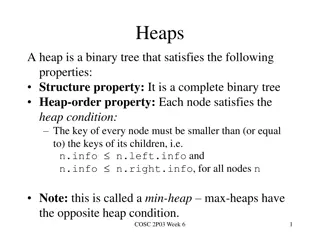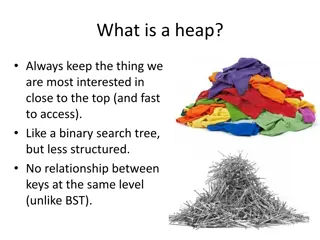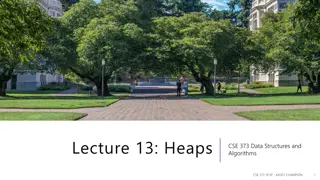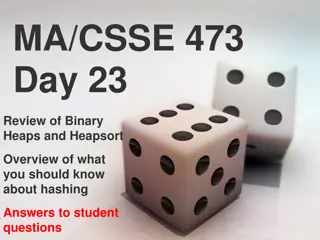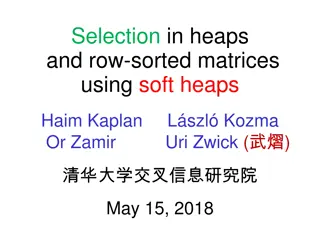Understanding Priority Queues and Heaps in CS2110
Delve into the realm of priority queues and heaps in the context of CS2110 during the Fall of 2015. Explore the differences between heaps and Binary Search Trees (BSTs) through desirable properties and advantages each structure offers. Discover how stacks and queues are implemented as restricted lists and learn about interface Bags and Priority Queues. Unveil examples of Priority Queues in real-world scenarios, such as job scheduling and airline check-ins.
Download Presentation

Please find below an Image/Link to download the presentation.
The content on the website is provided AS IS for your information and personal use only. It may not be sold, licensed, or shared on other websites without obtaining consent from the author. Download presentation by click this link. If you encounter any issues during the download, it is possible that the publisher has removed the file from their server.
E N D
Presentation Transcript
PRIORITY QUEUES AND HEAPS Lecture 17 CS2110 Fall 2015
Readings and Homework 2 Read Chapter 26 A Heap Implementation to learn about heaps Exercise: Salespeople often make matrices that show all the great features of their product that the competitor s product lacks. Try this for a heap versus a BST. First, try and sell someone on a BST: List some desirable properties of a BST that a heap lacks. Now be the heap salesperson: List some good things about heaps that a BST lacks. Can you think of situations where you would favor one over the other? With ZipUltra heaps, you ve got it made in the shade my friend!
Stacks and queues are restricted lists 3 Stack (LIFO) implemented as list add(), remove() from front of list Queue (FIFO) implemented as list add() on back of list, remove() from front of list These operations are O(1) Both efficiently implementable using a singly linked list with head and tail head 16 55 12 19 tail
Interface Bag (not In Java Collections) 4 interface Bag<E> implements Iterable { void add(E obj); boolean contains(E obj); boolean remove(E obj); int size(); boolean isEmpty(); Iterator<E> iterator() } Also called multiset Like a set except that a value can be in it more than once. Example: a bag of coins Refinements of Bag: Stack, Queue, PriorityQueue
Priority queue 5 Bag in which data items are Comparable Smallerelements (determined by compareTo()) have higher priority remove() return the element with the highest priority = least in the compareTo() ordering break ties arbitrarily
Examples of Priority Queues 6 Scheduling jobs to run on a computer default priority = arrival time priority can be changed by operator Scheduling events to be processed by an event handler priority = time of occurrence Airline check-in first class, business class, coach FIFO within each class Tasks that you have to carry out. You determine priority
Example: Airline check-in 7 Fixed number of priority levels 0,...,p 1 FIFO within each level Example: airline check-in add() insert in appropriate queue O(1) poll() must find a nonempty queue O(p) first class many miles paying frequent flier
java.util.PriorityQueue<E> 8 interface PriorityQueue<E> { boolean add(E e) {...} //insert an element void clear() {...} //remove all elements E peek() {...} //return min element w/o removing E poll() {...} //remove and return min element boolean contains(E e) boolean remove(E e) int size() {...} Iterator<E> iterator() }
Priority queues as lists 9 Maintain as unordered list add() put new element at front O(1) poll() must search the list O(n) peek() must search the list O(n) Maintain as ordered list add() poll() peek() must search the list O(n) must search the list O(1) O(1) Can we do better?
Heap 10 A heap is a concrete data structure that can be used to implement priority queues Gives better complexity than either ordered or unordered list implementation: add(): O(log n) poll(): O(log n) O(n log n) to process n elements Do not confuse with heap memory, where the Java virtual machine allocates space for objects different usage of the word heap
Heap 11 Binary tree with data at each node Satisfies the Heap Order Invariant: 1. The least (highest priority) element of any subtree is at the root of that subtree. Binary tree is complete (no holes) 2. Every level (except last) completely filled. Nodes on bottom level are as far left as possible.
Heap 12 Smallest element in any subtree is always found at the root of that subtree 4 6 14 21 8 19 35 22 38 55 10 20 Note: 19, 20 < 35: Smaller elements can be deeper in the tree!
Not a heap has two holes 13 4 Should be complete: * Every level (except last) completely filled. 6 14 * Nodes on bottom level are as far 21 8 19 left as possible. 22 55 10 20 missing nodes
Heap: number nodes as shown 14 children of node k: at 2k + 1 and 2k + 2 4 0 6 14 1 2 parent of node k: at (k-1) / 2 3 21 8 19 35 4 5 6 22 38 55 8 9 7 Remember, tree has no holes
We illustrate using an array b (could also be ArrayList or Vector) 15 Heap nodes in b in order, going across each level from left to right, top to bottom Children b[k] are b[2k + 1] and b[2k + 2] Parent of b[k] b[(k 1)/2] to parent 0 1 2 3 4 5 6 7 8 9 to children Tree structure is implicit. No need for explicit links!
add(e) 16 Add e at the end of the array If this violates heap order because it is smaller than its parent, swap it with its parent Continue swapping it up until it finds its rightful place The heap invariant is maintained!
add() 17 4 6 14 21 8 19 35 22 38 55 10 20
add() 18 4 6 14 21 8 19 35 22 38 55 10 20 5
add() 19 4 6 14 21 8 35 5 19 22 38 55 10 20
add() 20 4 6 5 21 8 35 14 19 22 38 55 10 20
add() 21 4 6 5 21 8 35 14 19 22 38 55 10 20
add() 22 4 6 5 21 8 35 14 19 22 38 55 10 20 2
add() 23 4 6 5 21 8 14 2 19 35 22 38 55 10 20
add() 24 4 6 2 21 8 14 5 19 35 22 38 55 10 20
add() 25 2 6 4 21 8 14 5 19 35 22 38 55 10 20
add() 26 2 6 4 21 8 14 5 19 35 22 38 55 10 20
add() to a tree of size n 27 Time is O(log n), since the tree is balanced size of tree is exponential as a function of depth depth of tree is logarithmic as a function of size
add() --assuming there is space 28 /** An instance of a heap */ class Heap<E> { E[] b= new E[50]; //heap is b[0..n-1] int n= 0; // heap invariant is true /** Add e to the heap */ public void add(E e) { b[n]= e; n= n + 1; bubbleUp(n - 1); // given on next slide } }
add(). Remember, heap is in b[0..n-1] 29 class Heap<E> { /** Bubble element #k up to its position. * Pre: heap inv holds except maybe for k */ private void bubbleUp(int k) { int p= (k-1)/2; // p is the parent of k // inv: p is parent of k and // every other elt satisfies the heap inv while (k>0 && b[k].compareTo(b[p]) < 0) { swap(b[k], b[p]); k= p; p= (k-1)/2; } }
poll() 30 Remove the least element and return it (at the root) This leaves a hole at the root fill it in with the last element of the array If this violates heap order because the root element is too big, swap it down with the smaller of its children Continue swapping it down until it finds its rightful place The heap invariant is maintained!
poll() 31 4 6 5 21 8 14 35 19 22 38 55 10 20
poll() 32 4 6 5 21 8 14 35 19 22 38 55 10 20
poll() 33 4 6 5 21 8 14 35 19 22 38 55 10 20
poll() 34 4 19 6 5 21 8 14 35 22 38 55 10 20
poll() 35 5 4 6 19 21 8 14 35 22 38 55 10 20
poll() 36 5 4 6 14 21 8 35 19 22 38 55 10 20
poll() 37 5 4 6 14 21 8 35 19 22 38 55 10 20
poll() 38 4 5 6 14 21 8 35 19 22 38 55 10 20
poll() 39 4 5 6 14 21 8 35 19 22 38 55 10 20
poll() 40 20 4 5 6 14 21 8 35 19 22 38 55 10
poll() 41 6 4 5 14 20 21 8 35 19 22 38 55 10
poll() 42 6 4 5 8 14 21 35 20 19 22 38 55 10
poll() 43 6 4 5 8 14 21 35 10 19 22 38 55 20
poll() 44 6 4 5 8 14 21 35 10 19 22 38 55 20
poll() 45 Time is O(log n), since the tree is balanced
poll(). Remember, heap is in b[0..n-1] 46 /** Remove and return the smallest element * (return null if list is empty) */ public E poll() { if (n == 0) return null; E v= b[0]; // smallest value at root b[0]= b[n-1]; // move last elt to root n= n - 1; bubbleDown(0); return v; }
/** Bubble root down to its heap position. Pre: b[0..n-1] is a heap except maybe b[0] */ private void bubbleDown() { int k= 0; // Set c to smaller of k s children int c= 2*k + 2; // k s right child if (c >= n || b[c-1].compareTo(b[c]) < 0) c= c-1; // inv: b[0..n-1] is a heap except maybe b[k] // Also, b[c] is b[k] s smallest child while (c < n && b[k].compareTo(b[c]) > 0) { swap(b[k], b[c]); k= c; c= 2*k + 2; // k s right child if (c >= n || b[c-1].compareTo(b[c]) < 0) c= c-1; } } 47
Trouble changing heap behaviour a bit 48 Separate priority from value and do this: add(e, p); //add element e with priority p (a double) Be able to change priority change(e, p); //change priority of e to p THIS IS HARD! THIS IS EASY! Big question: How do we find e in the heap? Searching heap takes time proportional to its size! No good! Once found, change priority and bubble up or down. OKAY
HeapSort(b, n) Sort b[0..n-1] 49 Whet your appetite use heap to get exactly n log n in-place sorting algorithm. 2 steps, each is O(n log n) 1. Make b[0..n-1] into a max-heap (in place) 1. for (k= n-1; k > 0; k= k-1) { b[k]= poll i.e. take max element out of heap. } We ll post this algorithm on course website A max-heap has max value at root
Many uses of priority queues & heaps 50 Surface simplification [Garland and Heckbert 1997] Mesh compression: quadric error mesh simplification Event-driven simulation: customers in a line Collision detection: "next time of contact" for colliding bodies Data compression: Huffman coding Graph searching: Dijkstra's algorithm, Prim's algorithm AI Path Planning: A* search Statistics: maintain largest M values in a sequence Operating systems: load balancing, interrupt handling Discrete optimization: bin packing, scheduling Spam filtering: Bayesian spam filter



